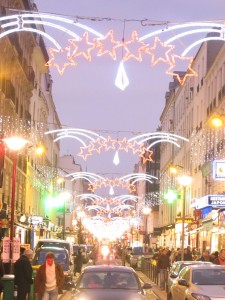 There are a handful of winter market options in New England, but nothing (yet) that compares to what’s available in Parisian markets all year round. Even during the shortest and coldest days of the year, food markets in Paris overflow with fresh produce, cheeses, meats, flowers, and all manner of temptation. Winter markets are especially fun with the chance to see holiday specialties that make their appearance only at this time of year. So, if you live in Paris or plan to visit over the holiday, don’t make the mistake of assuming that markets are stocked with only root vegetables. Go! You’re in for a treat.
There are a handful of winter market options in New England, but nothing (yet) that compares to what’s available in Parisian markets all year round. Even during the shortest and coldest days of the year, food markets in Paris overflow with fresh produce, cheeses, meats, flowers, and all manner of temptation. Winter markets are especially fun with the chance to see holiday specialties that make their appearance only at this time of year. So, if you live in Paris or plan to visit over the holiday, don’t make the mistake of assuming that markets are stocked with only root vegetables. Go! You’re in for a treat.
Thanks to Debbie Gabriel, an excellent writer, cook, and observer (not to mention her real jobs), we get a view into how holiday dinners are celebrated in France and how the winter markets reflect those tastes & traditions. Debbie explains that wild game is traditional. Lots of it can be found in the winter markets, along with other specialties that are unique to this time of year. They’ll show up in all sorts of delectable variations on holiday tables in just a matter of days. Enjoy Debbie’s newest guest post. And happy holidays! ~Marjorie
Seasonal Delights at the French Winter Markets
text & photos by Debbie Gabriel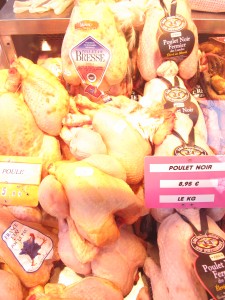
You know that the temperature has dropped in France when you start to see the seasonal offerings in the markets and shops in France. Rabbits, pheasant, and ducks in full fur on display. It’s a gorgeous spectacle of blues, reds, golds and sienna behind the glass at the butcher’s shop, or arrayed in the market stall. The confiseries-candy shops-are adorned with towers built out of seasonal confections. The menus in the bistros and fine restaurants transition to highlight the winter bounty.
My father-in-law, Jean, is an avid hunter, so deer (biche) and wild boar (sanglier) are always a part of our family’s Christmas tradition. In fact, throughout France, many holiday dinners are built around a main course of wild game. My mother-in-law, Simone, however, is an animal lover who abhors hunting. When they were a young couple, Simone once asked Jean if he would take her with him on the hunt. He was thrilled that she was interested and obliged. As a deer approached and Jean had it in his rifle sights, Simone jumped up and screamed to scare away his target, which bounded into the safety of the forest. For a long time she refused to cook his offerings. But now she embraces it, honing her game-cooking techniques and cadging tips from one of Jean’s hunting buddies, who is a chef in Burgundy.
In France, hunting was a royal obsession, and an activity reserved exclusively for the nobility. In 1789, the French Revolution democratized hunting, as it did other aspects of French life. And as they know how to do so well, the French developed game into a gastronomic revelation. 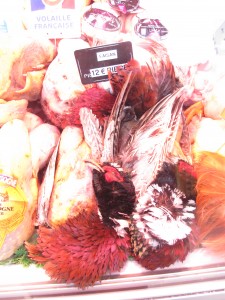 The cold weather brings game (gibiers) to the markets and bistros.
The cold weather brings game (gibiers) to the markets and bistros.
When I started visiting France 24 years ago with my then-boyfriend, I was fascinated by the winter markets and butcher shops showcasing the fruits of the hunting season. The chickens in the cases were fully intact, feathers and all, and rabbits hung from hooks. Alexandre laughed as I gasped. “What did you think — that chickens come wrapped in plastic?” he asked. Well, yes. I lived in New York City across from Citerella, one of Manhattan’s best butcher shops, and I had never seen meat presented that way.
Many of France’s foodie haunts put deer, wild boar, rabbit and wood pigeon on their seasonal menus and, typically, these entrees are beautifully prepared and presented. While you may be more inclined to warn a deer than eat one, if you want a true taste of French Christmas, order a roasted saddle of deer (“les dos de chevreuil” or “les dos de biche”). You won’t be disappointed.
We recently dined at Michel Rostang, a two-star Michelin restaurant. Several people ordered Les Dos de Chevreuil, a roasted deer in a peppercorn sauce with cranberry jelly spiked with sauterne wine. Others at the table had Le Lièvre à la Royale, a wild rabbit leg served over fresh pasta. Both were superb reflections of the French table in autumn. My mother-in-law makes civet de sanglier, or leg of wild boar. She marinates the meat in a mixture of red wine, cognac, olive oil, juniper berries, cloves, thyme and bay leaf for two days. Then she pats it dry, sears it and, finally, slow roasts the boar leg with the reserved marinade. This creates a tender meat and a rich sauce. This Christmas, we’re going to try a venison version of beef bourguignon.
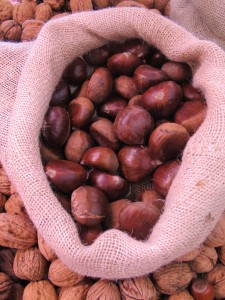 Simone always rounds out her Christmas menu with a side dish of chestnuts to accompany the turkey or wild boar. I’d seen chestnuts all over the parks and markets in Paris. My kids would collect them and compete with their classmates to amass the largest collections. I would find them in their coat pockets and backpacks, but it had never occurred to me that people ate them. I only thought of them as lyrics in classic American Christmas songs.
Simone always rounds out her Christmas menu with a side dish of chestnuts to accompany the turkey or wild boar. I’d seen chestnuts all over the parks and markets in Paris. My kids would collect them and compete with their classmates to amass the largest collections. I would find them in their coat pockets and backpacks, but it had never occurred to me that people ate them. I only thought of them as lyrics in classic American Christmas songs.
Simone tells me that the French have been eating chestnuts for centuries, dating back to the Romans. When she was younger, people ate more chestnuts than potatoes because they were everywhere. The potato was only introduced to France in the late 1700’s and was slow to gain popularity. Every Christmas she goes through the labor intensive process of boiling the whole chestnuts and then peeling them. Believe me when I tell you, it is a painstaking process.
Chestnuts have a thick outer shell that needs to soften first in boiling water. This also helps to loosen the membrane protecting it. Using a sharp knife, you score it and carefully peel off the shell. The fruit is fragile and it’s hard to remove the membrane and shell without breaking off pieces. But you only have to eat a few to understand why Simone goes to the trouble. Chestnuts are fantastic as a soup or savory; they are high in protein and are wonderfully dense and filling. They are delicious roasted or pureed with meat drippings to make a rich sauce. I’ve been converted and am now a fan.
Chestnuts make equally good sweets. One of the most ubiquitous French Christmas confections is the marrons glacés or candied chestnuts. The court of Louis XIV reportedly introduced them in 1667. Faugier Clemnet, located in the Ardèche region, was the first factory to make marrons glacés in the late 19th century. Ardèche is the country’s largest chestnut producer, harvesting and processing an average of 5000 tons a year – 50 percent of all French production. It earned its AOC (Appellation d’Origine Controlée) for chestnuts in 2000. The French initiated the AOC designation in 1935 to safeguard products and ensure quality. It means, for example, that only sparkling wine produced in the Champagne region can call itself champagne. 
France’s finest and best-known confectioners offer marrons glacés, among them, Pierre Hermé, Maison du Chocolat, Lenôtre, Jeff de Bruges, and Ladurée. They are beautifully packaged, individually wrapped in gold foil and come at a steep price, anywhere between 2-5 euros (approximately $7) apiece. The candy-making process has many stages: steaming and peeling whole chestnuts, macerating them for days in vanilla sugar syrups, and finishing them by slowly drying in the ovens. The result is a chestnut with a coating of sugar and a rich candied interior that is not overly sweet, but totally addicting. Lenôtre offers marrons glacés covered in chocolate and speckled with 24-carat gold leaf. I just picked some up as a gift.
The next time you are in France, try a marron glacé. You can buy them individually. But, understand — you may not be able to stop at just one!
What to Look for at the Winter Markets and Specialty Shops?
- Meats (note that the game meats are only available until February when hunting season ends): Biche-young female deer Chevreuil-young male deer Cerf- stag Faisan-pheasant Sanglier-wild boar Lièvre- Hare Perdreau-partridge Canard sauvage- wild duck Grouse- grouse Palombe- wood pigeon Canette- duckling
- Cheeses: Epoisse- a rich cows milk cheese from Burgundy, said to be Napoleon’s favorite cheese (mine too!) Vacherin Mont d’Or- a cows milk cheese from the Jura mountains Tomme de Savoie- an alpine cows milk cheese with a low fat content
- Fruit: Clementine oranges Lichies Chestnuts
- Other Winter treats:Fois gras Vin chaud

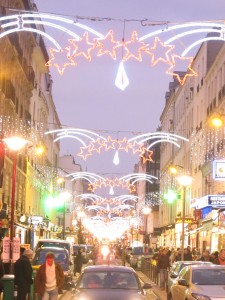
2 comments. Leave new
Love the food advice, am back in Paris in a few weeks! Can’t wait to check out the food markets too! Great inspiration thanks!
Thanks! Any details of what you found that you particularly enjoyed? Would love to hear!